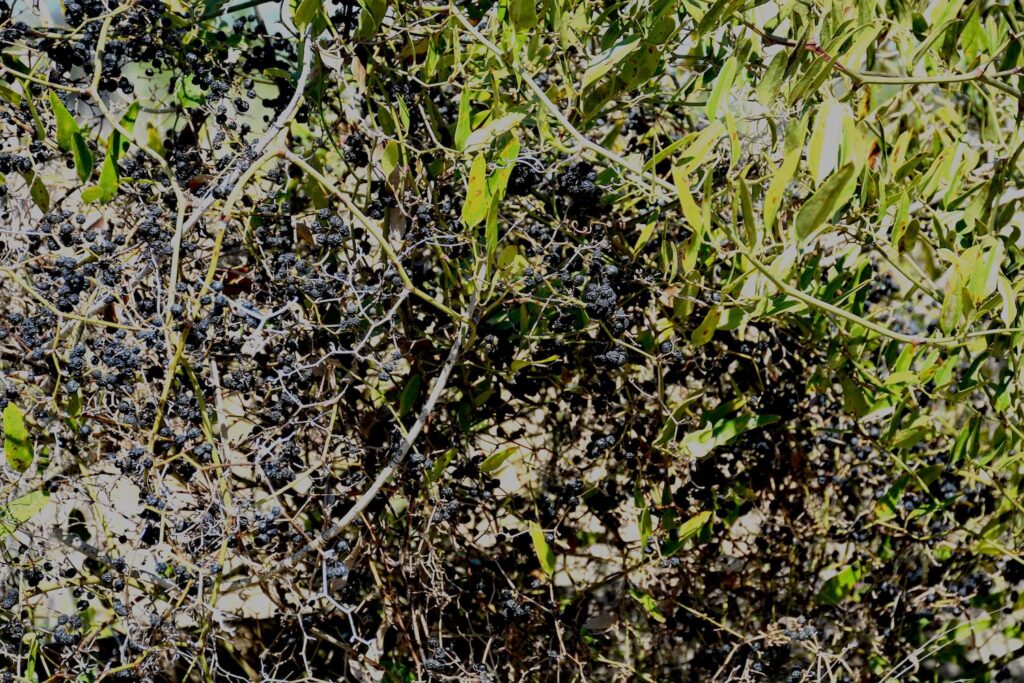
Often overlooked and rarely eaten are smilax berries. Photo by Green Dene
Smilax tips are famous as a wild edible, the berries not so much so. Indeed when I read on the internet “natives ate the berries like gum,” I know the writer never tried them. When young and green the berries are seedless, hard and astringent. Not gum material. A year later or so they will be black and shriveled often with a large seed inside. They can be a nice trailside nibble then. If they are shiny and plump I usually take them home and dehydrate them. In difficult times they could be a supplemental food source added to stews, soups and or salads. When the food bowl is empty every little bit helps to fill it.
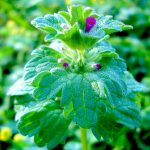
Henbit, one of the few “sweet” springtime greens. Photo by Green Deane
Also showing its seasonal presence is henbit, seen in Gainesville last weekend. Henbit was a favored winter green by the natives because it has a mild flavor. Most winter or springtime greens are strong flavored. While Henbit can be eaten raw it is best cooked. A dark-colored relative is called “dead nettle” and is equally edible. It is called dead nettle because it does not sting. And indeed, the stinging nettle is prolific now handing out many painful “bites” as it lurks in pellitory patches or patches of henbit and chickweed.
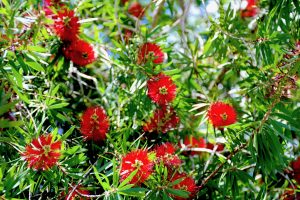
Bottle Brush Tree blossoms and leaves can be used for tea. Photo by Green Deane
The Greeks were perhaps the first people to call things what they were such as “yoke mate” for spouse or “shiny leather” for the Reishi mushroom. Then along came soft and flowery Latin. English, conversely, is punchy and muscular. It gets to the point quickly, Latin doesn’t. When you have a choice while writing always opt for English-based words over Latin-based ones. Extinguish The Conflagration doesn’t say it as well as Put Out The Fire! So when it came to a tree in which the leaves were used for tea it became the Tea Tree. And its oil became Tea Tree Oil with most folks forgetting the leaves can also be used for tea. The same down-to-earth approach was used with a very close relative to the Tea Tree, the Bottle Brush Tree, genus Callistemon. You can use the blossoms of the Bottle Brush Tree for tea or the leaves. The blossom tea tastes better and is slightly pink. Or, you can combine them. You can also use white Bottle Brush Tree blossoms for tea. By the way Latin was picked for scientific names because it is a dead language that doesn’t change because no native population speaks it. To read about the Bottle Brush Tree go here.
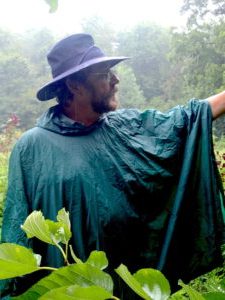
Classes are held rain or shine (but not during hurricanes.)
Foraging classes:
March 8th, John Chestnut County Park: 2200 East Lake Road, Palm Harbor, FL 34685. Meet at the trail head of the Peggy Park Nature Walk, pavilion 1 parking lot. 9 a.m. to noon.
March 9th, Mead Garden:1500 S. Denning Dr., Winter Park, FL 32789. Meet at the bathrooms. 9 a.m. to noon. (Don’t forget daylight savings time changes, it “springs” forward an hour)
Bring cash on the day of class or click here to pay for your class. If cost is a hardship email me at: GreenDeane@gmail.com.
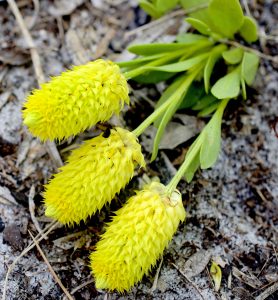
Candyroot can be yellow or orange, tall and short.
One gets used to seeing certain plants in certain places such as blueberries near oaks and pines. Dandelions also like acidic soil so they, too, can be found near oaks and pines. Lemon Bacopa (which tastes like lime) also seems to like specific places. I usually find it in the damp ruts of woods roads, or in damp spots on hiking trails, wet but sunny. Definitely not a suburban plant. Another site specific plant is Candyroot, pictured right. It is often found along wood roads or paths that can be damp, either all the time or seasonally (which can be confusing. I have found Candyroot in wet places and places that are seasonally wet but mostly high and dry the rest of the time.) In its tiny root it there is some methyl salicylate, smells like mint, birch, or checkerberries depending on your nose and where you grew up. It is a mild pain reliever. You can read about Candyroot here.
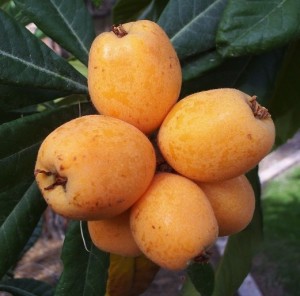
Loquats actually have a small amount of arsenic in them. Photo by Green Deane
An imported and naturalized tree that is fruiting now is the Loquat. It’s a very common backyard fruit tree which has liberated itself into the landscape. Most of the Loquats locally fruit in the spring but there is a variation that fruits in the fall, not common. I have seen a lot of Loquats in fruit this season. While it is commonly called the “Japanese Plum” it is not a plum nor is it from Japan but it is in the greater rose family. The fruit is edible from tart yellow to sweet yellow. The green fruit is toxic particularly to children, and contains some arsenic. You can read about the Loquat here.
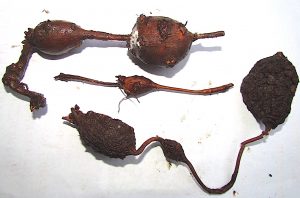
No other root has the growth pattern of the Groundnut east of the Rockies. Photo by Green Deane
The first export from the New World back to Europe was Sassafras wood. It was thought to be medicinal. The second export on any large scale was groundnuts, Apios americana. While gold fever later became a motive early explorations were for plants. John Smith, of Pocahontas fame, made careful botanical notes as he was good friends with the king’s gardener, John Tradescant. In his 909-page book, Florida Ethnobotany, Dr. Daniel Austin references Smith. In at least one case Austin prefers Smith’s observations some 400 years ago over that of a PhD. botanist in the 1930s. Smith incidentally, lived a full and a rather amazing life. You can read a little about him in my article about Spiderworts.
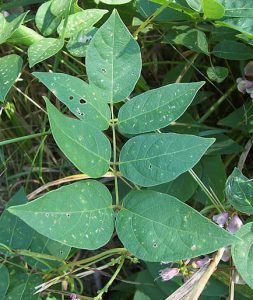
Groundnuts have leaflets of three, five and seven. Photo by Green Deane
We found some groundnut during as foraging class recently. No other plant east of the Rockies has a similar root growth pattern making it easy to identify. A legume with lumps on its root, it usually grows to about egg size but can be as large as a potato. It also has up to 26% protein, which is a whopping amount for a plant. The University of Louisiana developed a commercial cultivar and it can be bought on the internet if you don’t want to go find it. If folks ate groundnuts some 400 years ago — it was a staple for the natives from Maine to Florida — and it was shipped off to Europe as a food, and has been developed into a cultivar, why aren’t we eating it? Why isn’t it in the grocery stores? The answer is it takes a year to first establish itself. In the fast pace of modern agriculture that does not meet commercial practices. But it’s fine for people who like to grow their own food. You can read about the “lost crop” here.

You get the USB, not the key.
All of Green Deane’s videos available for free on You Tube. They do have ads on them so every time you watch a Green Deane video I get a quarter of one cent. Four views, one cent. Not exactly a large money-maker but it helps pays for this newsletter. If you want to see the videos without ads and some in slightly better quality you can order the DVD set. It is nine DVDs with 15 videos on each for a total of 135 videos. Many people want their own copy of the videos or they have a slow service and its easier to order then to watch them on-line. The DVDs make a good gift for that forager you know especially on long, cold winter months. Individual DVDs can also be ordered or you can pick and choose. You can order them by clicking on the button on the top right hand side of this page (if your window is open wide enough.) Or you can go here.

Green Deane Forum
Want to identify a plant? Looking for a foraging reference? Do you have a UFO, an Unidentified Flowering Object you want identified? On the Green Deane Forum we chat about foraging all year. And it’s not just about warm-weather plants or just North American flora. Many nations around the world share common weeds so there’s a lot to talk about. There’s also more than weeds. The reference section has information for foraging around the world. There are also articles on food preservation, and forgotten skills from making bows to fermenting food. One special section is “From the Frightening Mail Bag” where we learn from people who eat first then ask questions later. You can join the forum by clicking on “forum” in the menu.
 EAT THE WEEDS, the book, 274 plants, 367 pages, index, nutrition charts and color photos. It’s available in many locations including bookstores such as books a million, and Amazon. Most of the entries include a nutritional profile. It can also be ordered through AdventureKeen Publishing. This is weekly newsletter #628. If you want to subscribe to this free newsletter you can find the sign-up form in the menu at the top of the page.
EAT THE WEEDS, the book, 274 plants, 367 pages, index, nutrition charts and color photos. It’s available in many locations including bookstores such as books a million, and Amazon. Most of the entries include a nutritional profile. It can also be ordered through AdventureKeen Publishing. This is weekly newsletter #628. If you want to subscribe to this free newsletter you can find the sign-up form in the menu at the top of the page.
To donate to the Green Deane Newsletter click here.
In the spring of 2006 I decided to stop springing forward and in the autumn falling back. For 19 years I have ignored the time change. I do, however, rant about it semiannually. It all started with George Vernon Hudson.

G.V. Hudson is to blame. He thought up the nonsense at age 13.
Hudson, a New Zealander, collected insects and was a postal shift worker. In 1895 he proposed Daylight Savings Time so he could collect insects after work in daylight. The world rightly ignored his idea but it was also championed by a London golfer, William Willett, in 1907. He fought for it tirelessly and the world rightfully ignored him as well. But, to supposedly save energy during WWI, Germany adopted Daylight Saving Time and soon other countries in the conflict followed. The time pox has been on humanity since. In the fall Americans set their clocks back to standard time. In the spring they go back on artificial time.
As I have mentioned before I stopped changing my clocks nearly two decades ago. People who visit my home know I stay on “Deane Time.” I absolutely refuse to go on “daylight savings time.” The entire idea strikes me as silly particularly when one considers there is a fixed amount of daylight no matter how we set our clocks. Only the government would cut the top foot off a blanket, sew it on the bottom, and then argue the blanket is longer.
 What really got to me was the seasonal flipping: Springing forward, falling back, feeling miserable. Time change of any hind leaves me out of sorts for weeks. So I don’t flip. I don’t change the clocks, I don’t change when I get up, when I eat, when I go to bed or when I feed the animals. This family strictly stays on standard time. I just recognize that for part of the year the rest of the country thinks it’s ahead of me by one hour.
What really got to me was the seasonal flipping: Springing forward, falling back, feeling miserable. Time change of any hind leaves me out of sorts for weeks. So I don’t flip. I don’t change the clocks, I don’t change when I get up, when I eat, when I go to bed or when I feed the animals. This family strictly stays on standard time. I just recognize that for part of the year the rest of the country thinks it’s ahead of me by one hour.
From a factual point of view, the majority of people on earth do not go on Daylight Savings Time. How sensible. Asia doesn’t nor does Africa. Most equatorial countries don’t. Great Britain and northern Ireland tried staying on Daylight Saving Time permanently from 1968 to 1971 but went back because it was very unpopular. Most of Arizona does not go on DST, nor does Hawaii…. how do those folks manage…? Daylight Savings Time is a bad idea that needs to go away. It costs more energy now than it supposedly saves. You can refuse to let it disrupt your life. We all have phones and computers to remind us what the outside world thinks is the right time. Let them but keep your personal life on standard time. You can do it.
(In 2018 Florida passed a measure to stay on Daylight Savings Time permanently and screwed up royally. Called the “Sunshine Protection Act” it requires congressional approval because DST is a federal program. Florida’s request is not going to happen in a bitter, divided place like Washington D.C. which has other priorities than sunshine in the sunshine state. If Florida had decided to stay on standard time it could do that without federal approval (standard time is not a federal program) and we wouldn’t be flipping this weekend. Unless Florida revisits the legislation and changes it we (actually you) are stuck with flipping. It was an opportunity missed. You screwed up Tallahassee.)

